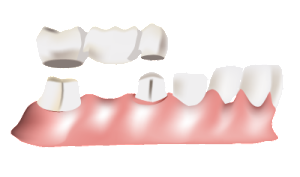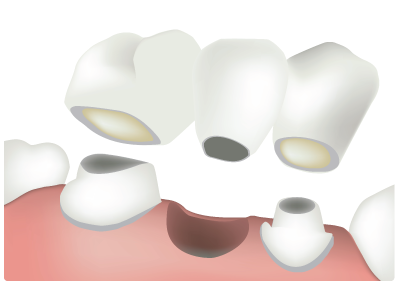Dental Bridge
Three-unit bridge replaces missing teeth
When a tooth is missing, a three-unit bridge can be a good choice for replacing it. In a three-unit bridge, an artificial tooth is connected on each end to crowns. The crowns are placed over the neighboring teeth to hold the bridge in place.
A three-unit bridge can be made of gold, porcelain, or porcelain fused-to-metal.
Placing a three-unit bridge
 When we first find periodontal disease, we treat it with scaling and root planing to remove plaque, tartar and bacteria from beneath your gumline.
When we first find periodontal disease, we treat it with scaling and root planing to remove plaque, tartar and bacteria from beneath your gumline.
We use the handpiece to remove any decay and shape the teeth that will support the bridge. Then we take an impression of your teeth. A model of your mouth is made from this impression, and then the lab uses the model to create a bridge that precisely fits your teeth and bite. In the meantime, we often place a temporary bridge.
On your next visit, we remove the temporary bridge and begin a series of steps to confirm the fit of your new bridge. We try in the final bridge and check the fit and your bite. When everything is right, we cement or bond the bridge in place.
Removing plaque below the gumline
This treatment disrupts the growth of the bacteria, but some bacteria remain and may settle back into the pocket where they reproduce. In fact, the number of bacteria doubles every time they reproduce, reaching destructive levels in as few as 90 days.
Three-unit bridges have several advantages. They:
- Replace teeth for biting and chewing
- Assist in clear speech
- Help prevent teeth from shifting
- Are supported by crowns that can serve as restorations for neighboring teeth that have damage or deca
When you need to replace a missing tooth, a three-unit bridge can be a functional, good-looking solution.


